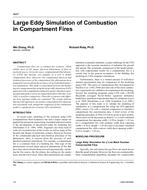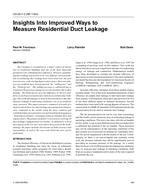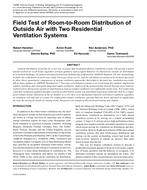Click here to purchase
Air flow and radiation exchange can have an important impact on the surface temperatures of glazing systems for evaluating the risk of condensation.Assessment of surface temperatures are essential in evaluating condensation risk with computer simulations. Methodologies, procedures and softwarealready exist for performing general condensation risk assessment. However, these are limited to steady state thermal simulation of the glazing system andthere are circumstances where such general assessments cannot fully account for in-situ conditions. One option to provide a more comprehensive simulationis to incorporate computational fluid dynamics (CFD) to simulate the effects of HVAC systems and model detailed air flow patterns around complexgeometry. However, there are questions regarding the feasibility of utilizing complex simulations such as whether the added complexity will lead to betterinsights, if the extra effort is justified, and what are the necessary procedures to move beyond standard design assumptions. This paper presents a two partinvestigation into the use of CFD for condensation risk assessment. The first part includes validation of two models, one is a benchmark problem basedon a simple wall assembly, and the other is a room scale CFD model validated against monitored data. The second part includes a case study of a roomscale CFD model with various HVAC systems to perform a diagnostic assessment of condensation risk. The validation portion investigates keyparameters and procedures that are required for an accurate CFD simulation such as the implication of dynamic film coefficients versus static filmcoefficients that are listed in the ASHRAE Handbook of Fundamentals. The diagnostic application involved the assessment of condensation on theinterior surfaces of a curtain-wall and sliding door at an outside corner. The inclusion of CFD simulations enabled the thermal model to account foradditional factors such as overhead diffusers, hydronic baseboard heaters, in-slab radiation heating, and obstructions such as a structural concrete column.
Citation: Thermal Buildings XIV 2019
Product Details
- Published:
- 2019
- Number of Pages:
- 12
- Units of Measure:
- Dual
- File Size:
- 1 file , 2.7 MB
- Product Code(s):
- D-Bldgs19-097


